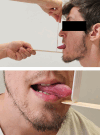How Passive Neck Immobilisation Influences Tongue Mobility and Strength: An Observational Study
- PMID: 39748134
- PMCID: PMC12037935
- DOI: 10.1111/joor.13926
How Passive Neck Immobilisation Influences Tongue Mobility and Strength: An Observational Study
Abstract
Background: There is a physiological association of the neck movements and jaw and tongue movements. However, there are no previous data regarding the performance of the tongue when the neck is under a lack of movement condition.
Objective: To quantify the tongue's maximal strength and mobility under an experimental restriction of cervical mobility.
Methods: This cross-sectional study recruited 33 healthy volunteers. We measured the tongue's mobility and maximal strength reached at the posterior, middle and anterior parts of the tongue; all were performed with and without neck immobilisation. A neck collar was used for the experimental restriction of cervical mobility.
Results: ANOVA revealed no differences in tongue strength between cervical condition (p = 0.84), but differences were found among the three tongue areas' strength (p < 0.001), according to the post hoc results the posterior area of the tongue resulted significantly weaker compared to the anterior (with collar p = 0.006; without collar p = 0.01) and midparts (with collar p = 0.03; without collar p = 0.006). Significant differences were also found in the tongue's range of motion (ROM) between groups for the protraction (p = 0.02). A subclassification of the participants was made according to the greatest strength obtained with (CCI group) or without (WCI group) neck collar, or no difference (NC group). The analysis of variance showed significant changes in tongue strength between groups at the tongue's anterior area (F = 5.28; p = 0.01), middle area (F = 9.83; p < 0.001) and posterior area (F = 4.05; p = 0.02). The post hoc analyses showed strength in the middle area of the tongue changed between neck conditions, obtaining significantly greater results without the neck collar compared with those with the neck collar (p = 0.01; d = 1.10).
Conclusion: The results of this study indicate a trend suggesting that posture induced by experimental cervical fixation may influence tongue strength, with a possible greater effect in the middle area of the tongue compared to the anterior and posterior areas; however, it affects tongue range of motion. These findings suggest that cervical posture could be an important factor to consider in clinical assessments and interventions involving tongue function. Nonetheless, a larger sample size and further studies are needed to draw more definitive conclusions and understand these potential associations.
Keywords: immobilisation; movement; muscle strength; neck; posture; tongue.
© 2024 The Author(s). Journal of Oral Rehabilitation published by John Wiley & Sons Ltd.
Conflict of interest statement
The authors declare no conflicts of interest.
Figures




Similar articles
-
Neck muscle strength and mobility of the cervical spine as predictors of neck pain: a prospective 6-year study.Spine (Phila Pa 1976). 2012 May 20;37(12):1036-40. doi: 10.1097/BRS.0b013e31823b405e. Spine (Phila Pa 1976). 2012. PMID: 22024906
-
Does altered mandibular position and dental occlusion influence upper cervical movement: A cross-sectional study in asymptomatic people.Musculoskelet Sci Pract. 2017 Feb;27:85-90. doi: 10.1016/j.math.2016.06.007. Epub 2016 Jun 15. Musculoskelet Sci Pract. 2017. PMID: 27847242
-
Effectiveness of Adjustable Cervical Orthoses and Modular Cervical Thoracic Orthoses in Restricting Neck Motion: A Comparative In vivo Biomechanical Study.Spine (Phila Pa 1976). 2015 Oct 1;40(19):E1046-51. doi: 10.1097/BRS.0000000000001013. Spine (Phila Pa 1976). 2015. PMID: 26076435
-
Motion generated in the unstable cervical spine during the application and removal of cervical immobilization collars.J Trauma Acute Care Surg. 2012 Jun;72(6):1609-13. doi: 10.1097/TA.0b013e3182471d9f. J Trauma Acute Care Surg. 2012. PMID: 22695429
-
Pediatric cervical kyphosis in the MRI era (1984-2008) with long-term follow up: literature review.Childs Nerv Syst. 2022 Feb;38(2):361-377. doi: 10.1007/s00381-021-05409-z. Epub 2021 Nov 22. Childs Nerv Syst. 2022. PMID: 34806157 Review.
References
Publication types
MeSH terms
LinkOut - more resources
Full Text Sources

